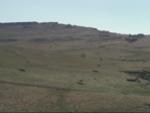

The Greenland Isotope Project
By Jette Arneborg
The aim of the Greenland Isotope Project is to study Norse Greenland diet and resource utilisation and management.
While the animal bones found in the middens of the Norse houses reflect the economy of the farm, they do not provide quantitative information on the human diet itself, and other approaches are necessary. One such method is to determine the stable isotope ratios of the remains of the human themselves. In particular, the ratio of the carbon isotopes 13C and 12C differs for terrestrial and marine food chains and thus can provide information on the relative amounts of terrestrial and marine protein in the diet. Another isotope ratio, 15N/14N, also reflects the marine or terrestrial nature of dietary protein and provides additional information on the level of the food chain from which that protein was obtained.
An initial study of 25 Norse skeletons suggested that, during the ca. 500 years the settlements lasted, the Norse Greenlanders changed their diet from a predominantly terrestrial diet to a more marine diet. One explanation could be the climate changes that took place in the Middle Ages, but we cannot rule out others, such as overexploitation of the natural resources followed by erosion and ruined pastures, which may have forced the Norse Greenlanders to turn to the sea for food.
In the Greenland Isotope Project a large number of samples – not only of human bones – but also samples of livestock and the wild fauna form part of the study. The aim is not only to expand the human sample, but also to examine the reliability of the method itself.
In order to evaluate the Norse Greenland situation in a North Atlantic perspective, samples from Iceland and The Faeroes also form part of the study. Also, for reasons of comparisons, the project includes analyses of human Eskimo bones and animal bones from Eskimo sites.
The publication of the Greenland section of the project is planned for 2006.
The research group

Jette Arneborg, National Museum of Denmark.
H.C. Gulløv, National Museum of Denmark.
Jan Heinemeier, Institute of Physics and Astromony, University of Aarhus.
Niels Lynnerup, Laboratory of Biological Anthropology, The Panum Institute.
Jeppe Møhl, Zoological Museum, University of Copenhagen.
Erle Nelson, Archaeology Department, Simon Fraser University.
Niels Rud, Institute of Physics and Astromony, University of Aarhus.
Arny Sveinbjörnsdóttir, Science Institute, University of Iceland.
Gudmundur Ólafsson, The National Museum of Iceland, Reykjavik.
Simun Arge, The National Museum of The Faroe Islands, Tórshavn.
Publications
Arneborg, J.; Heinemeier, J.; Lynnerup, N.; Rud, N.; Sveinbjörnsdóttir, Á.E. (2002) C14-dateringer af menneskeknogler – med de grønlandske nordboer som eksempel. Hikuin 27. Højbjerg pp. 307 – 314.
Arneborg, J.; Heinemeier, J.; Lynnerup, N.; Nielsen, H.L.; Rud, N.; Sveinbjörndóttir, Á.E. (2002) C-14 datings and the disappearance of Norsemen from Greenland. Europhysics news may/june pp. 77 – 80.
Arneborg, J.; Heinemeier, J.; Lynnerup, N.; Nielsen, H.L.; Rud, N.; Sveinbjörnsdóttir, Á.E. (1999) Change of diet of the Greenland Vikings determined from stable carbon isotope and 14C dating of their bones. Radiocarbon. Vol. 41(2) pp. 157 – 168.
